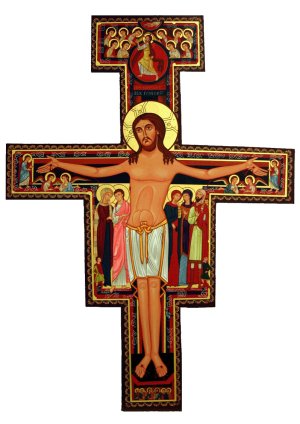San Damiano Cross
The original cross, fashioned about 1100, hangs in Santa Chiara Church in Assisi. When in 1257, the Poor Clares moved to Santa Chiara, they took the San Damiano Cross with them and still guard it with great solicitude. The crucifix now hanging over the altar of the ancient church of San Damiano is a copy.
Type of Cross
The cross is called an icon cross because it contains images of persons who have a part in the meaning of the cross. The tradition of such crosses began in the Eastern Church and was carried by the Serbian Monks to the Umbrian district of Italy. The Byzantine style was common in Italy before Cimabue and Giotto. The San Damiano Cross was one of a number of crosses painted with similar figures during the 12th century in Umbria. The purpose an icon cross was to teach the meaning of the event depicted and thereby strengthen the faith of the people.
Christ Crucified
Jesus Christ is represented both as wounded and strong. He stands upright and resolute. His halo already includes the pictures of the glorified cross. The bright white of the Lord's body contrasts with the dark red and black around it and, therefore, accentuates the prominence of Jesus. He projects the life of divine nature in a body pierced by nails in the hands and feet, by the crown of thorns on his head, and by the soldier's lance in his side. This representation contrasts with the regal Christ portrayed on the cross in earlier centuries and the suffering, dying, crucified Christ depicted generally throughout the church beginning throughout the 14th century. Christ is represented in full stature while all the others are smaller in stature. Above the head of Christ is the inscription in Latin: Jesus of Nazareth, King of the Jews.

Major Witnesses
The next largest figures are the five witnesses of the crucifixion and witnesses of Jesus as Lord. On the left side are Mary, Mother of Jesus, and St. John the Beloved, to whom Jesus gave his mother. On the right side are Mary Magdalene, Mary, Mother of James, and the centurion who in Mark's gospel proclaims, "Truly this is the Son of God." Both Mary and Mary Magdalene have their hands placed on their cheeks to reflect extreme grief and anguish. The first four witnesses are saints who gave their lives for the Lord and are therefore represented with halos of sanctity. The names of the five major witnesses are written beneath their pictures.
Minor Witnesses
The three smaller figures are represented as witnessing the crucifixion. On the lower left is Longinus the Roman soldier who pierced the side of Jesus with a lance. He is represented here as holding the lance and looking up at Jesus. The blood running down the arms of Jesus begins at the elbow to drip straight down. It will land on the upturned face of Longinus. In the lower right is Stephaton who is identified as the soldier who offered Jesus the sponge soaked in vinegar wine. From the posture of his figure, you can see that he holds the staff and sponge in the same way that Longinus holds the spear.
Peering over the left shoulder of the centurion is a small face. A close look at the face reveals the tops of the heads of three others beside him. In accord with the conventions of the time, this may be the face of the artist who was claiming authorship and immortalizing himself as a witness to Christ.
The Angels
Six angels are represented as marveling over the event of the crucifixion. They are positioned at both ends of the crossbar. Their hand gestures indicate they are discussing this wondrous event of the death and calling us to marvel with them.
The Patron Saints
At the foot of the cross there is a damaged picture of six figures, two of whom are represented with halos. In accordance with the traditions of the day, these six are the patrons of Umbria: St. John, St. Michael, St. Rufino, St. John the Baptist, St. Peter and St. Paul.
The Heavenly Welcome
On the top of the cross, we see Jesus now fully clothed in his regal garments and carrying the cross as a triumphant scepter. He is climbing out of the tomb and into the heavenly courts. Ten angels are crowded around. Five of them have their hands extended in a welcoming gesture to Jesus, who himself has his hand raised in the form of a greeting.
The Right Hand of God
At the very top of the cross is the right hand of the Father with two fingers extended. Jesus is being raised from the dead by the right hand of God the Father. This can also be understood as the blessing of God the Father on all that Jesus has done.
The Bird and Animal
On the right side of the picture next to the left calf of Jesus, there is a small figure of a fowl. Some art historians have interpreted it to be a rooster, representing the sign of Jesus' betrayal. Other commentators see it as a peacock, a frequent symbol of immortality in early Christian art. Along the lower right side of the shaft, there is a small animal, possibly a cat.
(Adapted from Michael Scanlan, T.O.R., The San Damiano Cross: An Explanation, Franciscan University Press, Steubenville, Ohio, 1983.)
